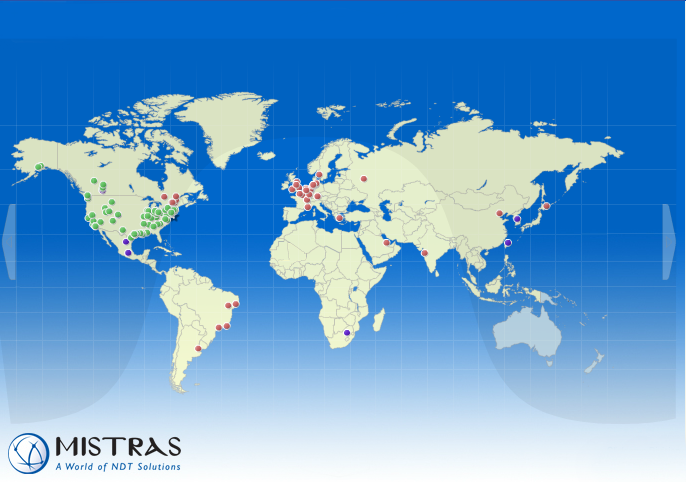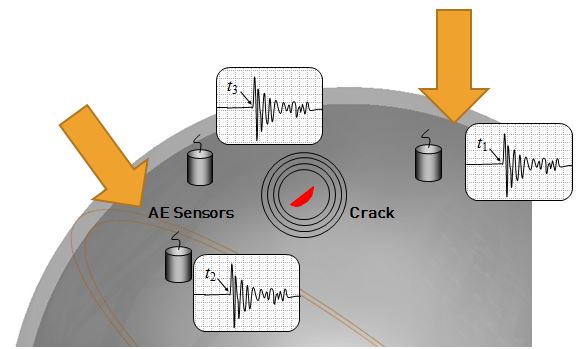 |
|
Ανακύκλωση
Τα οφέλη της ανακύκλωσης τόσο σε περιβαλλοντολογικό όσο και σε οικονομικό επίπεδο είναι τεράστια. Για την μεγιστοποίηση όμως των οικονομικών απολαβών χρειάζεται σωστή και γρήγορη διαλογή των προς ανακύκλωση υλικών. Για την διευκόλυνση στον τομέα της διαλογής μεταλλικών και όχι μόνο αντικειμένων, διατίθεται μεγάλη ποικιλία από αναλυτές XRF με τους οποίους η ταυτοποίηση των μετάλλων γίνεται σε μόλις λίγα δευτερόλεπτα στον τόπο συλλογής.
Pt, Pd and Rh Analysis with Portable XRF
The portable DELTA X-ray Fluorescence analyzer provides a high level of performance when measuring metals such as Pt (Platinum), Pd (Palladium), and Rh (Rhodium) in catalytic converters. All new cars today are equipped with catalytic converters for significant reduction of harmful emissions such as carbon monoxide (CO), hydrocarbons (HC) and nitrogen oxides (NOx).lysis, providing vital information at that precise moment and not weeks later.
Certain chemical reactions in an automotive catalytic converter transfer the harmful substances into carbon dioxide (CO2), water (H2O) and nitrogen (N). To optimize and speed up these reactions, catalyst elements such as the three platinum group metals (PGM) Platinum (Pt), Palladium (Pd) and Rhodium (Rh) are used in the converters.
DELTA handheld X-ray Fluorescence (XRF) analyzers provide convenient, easy, on-the-spot measurements of automotive catalysts with
- high precision and accuracy within 1 - 2 minutes
- excellent analytical performance close to the wet chemistry results
Benefits:
- rapid identification of worthless monoliths (unloaded or washed-out)
- rapid sorting of catalysts converters of different value levels for the recovery of the precious metals Pt, Rh and Pd
- precise PGM concentration in minutes for price calculation
The DELTA XRF analyzer also provides high quality results for additional catalyst metals such as Ti, Cr, Mn, Fe, Ni, Cu, Zn, Pb, Bi, Sr, Zr, W, Se and Ce.
Every new vehicle is outfitted with a new type of catalyst. Consequently, each year several hundred different types of catalysts are produced resulting in a great variation in the PGM loadings.
Recycling of Automotive catalysts for the recovery of Pt, Pd and Rh helps saving the natural resources, reduces costs required for traditional mining techniques and saves the environment. Catalytic converter scrap also has a much higher content of Pt, Pd and Rh than ores.
The recoveries of Pt, Pd and Rh from used automotive catalysts will also satisfy the demand for the new production. The proportion of recycled PGM in the production of new catalyst converters is constantly increasing.
Hundreds of users all over the world – from collector to refiner – have confidence in the reliability of the DELTA handheld XRF analyzer to monitor incoming or outgoing materials. With 40 - 60 thousand different types of catalytic converters on the market identifying and calculating its value only by part numbers or shapes is not practical. Therefore fast and reliable analytical methods for accurate analysis are critical for the daily business for QC, sorting, and price evaluation for buying and selling.
| Washcoat | Conc. in wt% |
| Pt | 0 – 1.3 |
| Pd | 0 – 2.5 |
| Rh | 0 – 0.15 |
Typical concentration of the Platinum group metals in ceramic based car catalyst converters.
Olympus XRF Analyzers – Performance You Can Count On
While benefiting from the convenience of easy, on-thespot analysis with an Olympus Handheld XRF, you can be confident in results that will help assure maximum profit of fast sorting of the material.
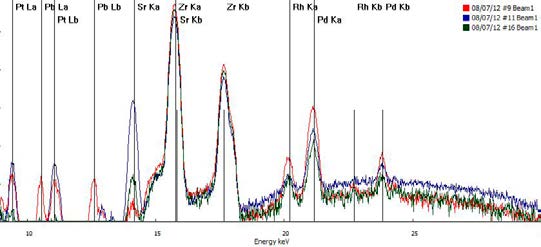
Typical XRF Spectra of Automotive Catalytic Converter elements.
Our unique hardware and software combination allows us to create specific calibration models for compensating side effects caused by the complex chemistry and varying concentration of the other elements in the washcoat like Zr, Sr, Ba, and Ce but also pollutants like Pb and other elements like W and Se in the ceramic substrate.
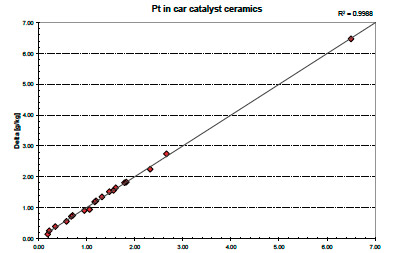
Correlation curve from measurement of CC samples with known Pt content.
In addition to Pt, Rh and Pd, the DELTA analyzer provides a high level of performance for other metals of interest. The OIX XRF analyzers detect also Ti, Cr, Mn, Fe, Ni, Cu, Zn, Pb, Bi, Sr, Zr, W, Se and Ce.
| Sample | Pt % Lab | XRF Analyzer |
| CC 3 | 0.119 | 0.119 |
| CC 7 | 0.095 | 0.095 |
| CC 8 | 0.058 | 0.054 |
| CC 9 | 0.156 | 0.156 |
| CC 10 | 0.161 | 0.163 |
| CC 14 | 0.035 | 0.040 |
| Sample | Pd % Lab | XRF Analyzer |
| CC 3 | 0.057 | 0.051 |
| CC 7 | 0.061 | 0.057 |
| CC 8 | 0.080 | 0.077 |
| CC 9 | 0.065 | 0.062 |
| CC 10 | 0.057 | 0.056 |
| CC 14 | 0.018 | 0.018 |
| Sample | Rh % Lab | XRF Analyzer |
| CC 3 | 0.018 | 0.018 |
| CC 7 | 0.022 | 0.023 |
| CC 8 | 0.024 | 0.022 |
| CC 9 | 0.018 | 0.018 |
| CC 10 | 0.012 | 0.012 |
| CC 14 | 0.008 | 0.009 |
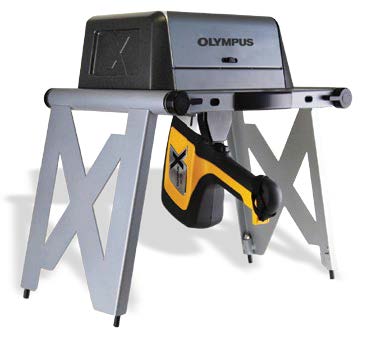
DELTA Portable Workstation with integrated safety-lock shielding for powdered or small objects; a PC is connected for remote control of this closed-beam DELTA set-up.
Being able to separate wanted from unwanted material has always been the goal in the scrap recycling industry, and with good reason: knowing the type/quality of scrap coming into your yard prevents pricing errors; supplying the cleanest scrap to your customers saves them time and provides you with the most profit.
High-quality separated materials produce the highest quality final product. If manufacturers, fabricators, smelting operations-your customers-feel confident that you can supply the material they want at the purity they need, you have created a win-win situation: they know they can rely on you, and you get a long-term customer.
Scrap sorting has come a long way since the "watch for the color of the grinding spark" days. Today, large auto-shredding facilities and drive-in small batch yards have moved on to a more technological sorting process.
Most scrap processors are familiar with Eddy Current separators (using magnets to separate ferrous metals from non-ferrous metals) and Optical Emission spectrometers (OES), also known as Arc / Spark (creating a spark that causes electrons to emit light waves).
X-ray fluorescence, or XRF, is a fast, accurate, and relatively easy way to detect and separate the more difficult metal alloys and grades. Correct sorting allows you to accurately price the material coming into your yard, and to provide a purer scrap product to your customers.
Over the past decade or so, XRF has been miniaturized into handheld "alloy analyzers", but is also available for on-line automated sorting of bulk material, for example in shredding operations. So whatever the size of your scrap operation, XRF sorting equipment has a place in it.
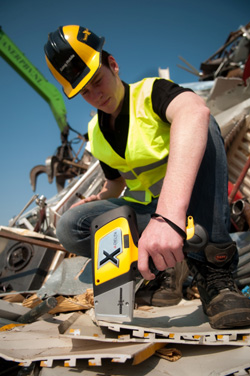
XRF Technique
Nearly all elements, from iron to copper to nickel to tungsten, have unique and known X-ray signatures. When an X- or Gamma-ray is absorbed by an element, the element fluoresces, or emits energy. Inner-shell atomic fluorescence produces the X-ray signature, and can be "captured" and reported.
XRF analyzers do both tasks: they provide the incident X-rays that generate the excitation in the atoms and then detect the fluorescence from most* of the elements in the sample material. Based on this, XRF equipment will also provide an analysis of which elements comprise the sample and at what percentages. Most will also provide grade identification, based on a comparison between the compositional analysis results and a grade specification library.
XRF detects multiple elements simultaneously, which makes it an excellent choice for sorting grades of stainless steel or aluminum, and separating glass streams.
*XRF can generally not detect and measure "lighter" elements such as carbon.
Sorting not just series, but grades of alloys
XRF has traditionally been used for basic stainless sorting, and nonferrous alloy grade separations, and with advances in the technology, it has moved onto more advanced detection.
Take Stainless grades 304 and 316. They look the same, they weigh approximately the same, and neither is magnetic. XRF can sort 304 from 316 because it can detect the approximately 2% molybdenum that's in the 316. That makes the price of 316 higher than 304 because molybdenum is a high-value element.
Stainless 304 and 347 both have-in addition to other elements-chromium and nickel, but they have different niobium content. XRF can detect each element's concentration and reliably sort the alloys in a test that takes less than one-second.
For light alloys, Handheld XRF has been typically limited for the separation of gross alloy series (for example, 2000 from 7000 series aluminum alloys). OES has traditionally been the portable technology of choice for sorting Al alloys. But with recent advances in handheld XRF alloy analyzers, they can now be used for more extensive grade separations within series.
A common wrought Aluminum alloy, 3003, is recognizable based on manganese (Mn) content. Sorting 3003 from other Al alloy series has been straight-forward for handheld XRF for years. With current Handheld XRF though, further separation of 3003 from 3004 and 3005, based on small amounts of magnesium (Mg) content-a light element just recently possible to analyze with good precision-is possible, at least with high-end handheld XRF.
But grade separation is not about just one element. Aluminum grades 6061 an 6063 have the same eleven elements and no others. The latest XRF alloy analyzers can discern one or the other based on the concentrations measured, with even a very short test.
Being able to sort and separate alloy grades, and examine materials for tramp residuals or poisons creates incremental value, happy customers and ultimately nice profits.
The hard stuff
On-line XRF automatically separates types of scrap that other technologies simply can't.
The three most popular scrap types that only XRF systems can separate in high speed sorting systems are: meatballs (electric motor alternators consisting of copper wire wound around iron cores), glass, and high-end nonferrous separation (i.e. grades of stainless steel and certain Aluminum grades.
Meatball Sorting
Meatballs cannot be efficiently separated out efficiently from shredded scrap streams by hand, eddy current or optical emission spectroscopy (OES). Since eddy current creates magnetism, the iron in the meatballs will be attracted to the magnet, along with every other piece of ferrous scrap. Optical emission sparking is too narrowly focused to detect all the metals in the meatball without multiple tests. The current method of separation, manual separation is slow, labor intensive, and prone to error.

Automated XRF, however, works at the elemental level, and can simultaneously cover a broad testing area. It can quickly detect the copper in the meatballs in one fast pass, allowing immediate automatic sorting.
Glass Sorting
Ceramic glass-the kind used in cookware-cannot be mixed with standard glass if the cullet is to be recycled. Ceramic glass has a higher/different melting temperature than bottle/container glass (i.e, "regular glass). When new glass is made, if glass ceramic is mixed in it won't melt properly, which results in inclusions/defects in the new glass. Different melting temperatures can also cause issues in the glass production process, including damaging expensive production equipment.
Leaded glass, like from CRTs, crystal goblets, and chandeliers, offer the same problems as ceramic glass.
XRF can quickly and accurately detect these types of glass. Customers that have confidence in your ability to separate ceramic and leaded glass from standard glass will be your customer for a long time.
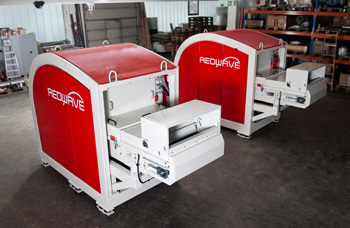
Colored glass gets its color from metals: cobalt for blue, iron for green, and sulfur or carbon for amber/brown. Recycled glass retains its color, so the cleaner the glass cullet you can supply, the truer the color of the final product.
Much of glass sorting is visual; is it blue, green, amber, or clear. But visual sorting is slow and error-prone. XRF sorting equipment can be calibrated to detect cobalt if the stream is a combination of clear glass mixed with blue, or it can be calibrated to detect any of the other metals to separate the other colors. Multiple XRF systems can be employed to: separate all colored glass from clear; blue from green and amber; and finally green from amber.
Aluminum Sorting
While it may be a simple weight or magnetic test to separate aluminum from other metals, determining the difference between types of aluminum has always been a challenge. All aluminum alloys are the same silver / grayish color, and all of them are lightweight. For example, 7000 series Aluminum alloys appear the same as 6000 series. Current recyclers are demanding an automated method fro separating these two alloys.
XRF can rapidly sort 7000 and 6000 series, as well as other series, and grades within those series.
How XRF can be used in recycling industry
XRF can be used in big recycling facilities and small, and for a range of scrap sorting needs.
Automobile shredding operations can incorporate XRF technology into existing sorters to refine separation, i.e., XRF analyzers added in series after an eddy current head can further separate ferrous items that also contain wanted (or unwanted) metals, and detect them in milliseconds.
Handheld XRF alloy analyzers can accompany you to demolition sites to determine the type of material that the site contains, allowing you to bid accurately (and more quickly than your competitors!).
Sorting and element detection with XRF is user configurable. Whatever changes in your scrap stream, XRF analyzer systems can be modified to adapt to the new need. An XRF analyzer that was being used to detect copper poison in low alloy steels in the morning can be used for fine sorting of aluminum alloys in the afternoon.
The current state of XRF technology can detect elements from Magnesium to Uranium, with ever improving sensitivities. As such, the breadth of material that is sort-able with this technology continues expanding.
Glass is an easily recyclable material if processors can accurately and cost effectively separate clean, furnace-ready glass cullet from other commingled and/ or contaminated waste, such as ceramics and metals.
The X-STREAM-G high volume glass sorting and separating system uses proven X-ray Fluorescence (XRF) technology to sort glass by highly specific material chemistry, providing the most economically viable solution to identify and extract specific cullet contaminants including:
- Leaded Crystal
- Glass Ceramic, PyroCeram, High Temp Glass
- Cu, W, Al and other metals
- Pb, Br, Sn, Sb and other toxic elements
X-STREAM-G Advantages:
- Rapidly determine by chemistry - not density
- Capacities of many tons per hour available
- Flexibility to handle new applications to meet market demands
- "See" a wider range of materials
- Industrially hardened and reliable for low CoO
| X-STREAM-G Typical PerformanceThe X-STREAM-G is robustly engineered to process high volumes of materials, with minimal loss of recyclable cullet. Processing volumes are scalable to meet client requirements. Typical analysis time is on the order of a few milliseconds, with high levels of accuracy.
X-STREAM-G Operation ModeThe X-STREAM-G can be placed before or after crushing equipment and detects glass contaminants as the materials move onto slide-ways or conveyors and then diverts them from the processing line.
|
X-STREAM-G Performance Data
Glass recyclers/processors need to detect small pieces of glass ceramic and leaded crystal in cullet. Specific elemental markers have been used to successfully identify and remove these materials from the clean cullet.
Spectral comparison of leaded crystal, glass ceramic, and container glass. Taken under typical dwell times of <100 ms.
Introduction
Dental alloys are alloys specially developed for the dental industry. They often contain precious metals like Gold, Silver, Platinum and Palladium.
In the dental field, there are now far more than 1000 different alloys, with the precious metal alloys (high-gold, gold-reduced, palladium-based and silver-base alloys) in the majority.
These elements form the basic material for the dental alloys used in amalgams, crowns, bridges and other dental fittings. Once removed, they are a valuable precious metals resource. Together, with other precious metal scrap (x-ray fixers and films, castings and their materials, trap filters, wipes,sweeps, and grindings from bench work), these products are processed by precious metal refiners. Compositional analysis is a critical part in the valuing and quality control of these materials. Not only is a visual test unreliable, but the weigh difference between karats may be negligible.
XRF Analyzers
Performance You Can Count On
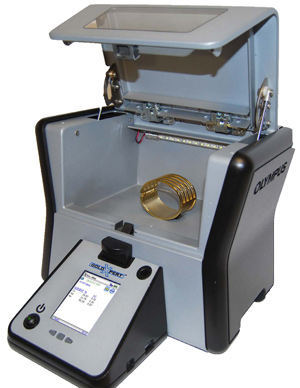
The GoldXpert can be configured specifically for the measurement of precious metals in dental alloys. In addition to Au, Ag, Pt, and Pd the GoldXpert provides high level of performance of other elements like Ti, Cr, Mn, Fe, Ni, Cu, Zn, Ru, Rh, Zr, W, Ga, In, and others.
Ελ. Βενιζέλου 7 & Δελφών, 14452 Μεταμόρφωση, Αθήνα, Ελλάδα |

